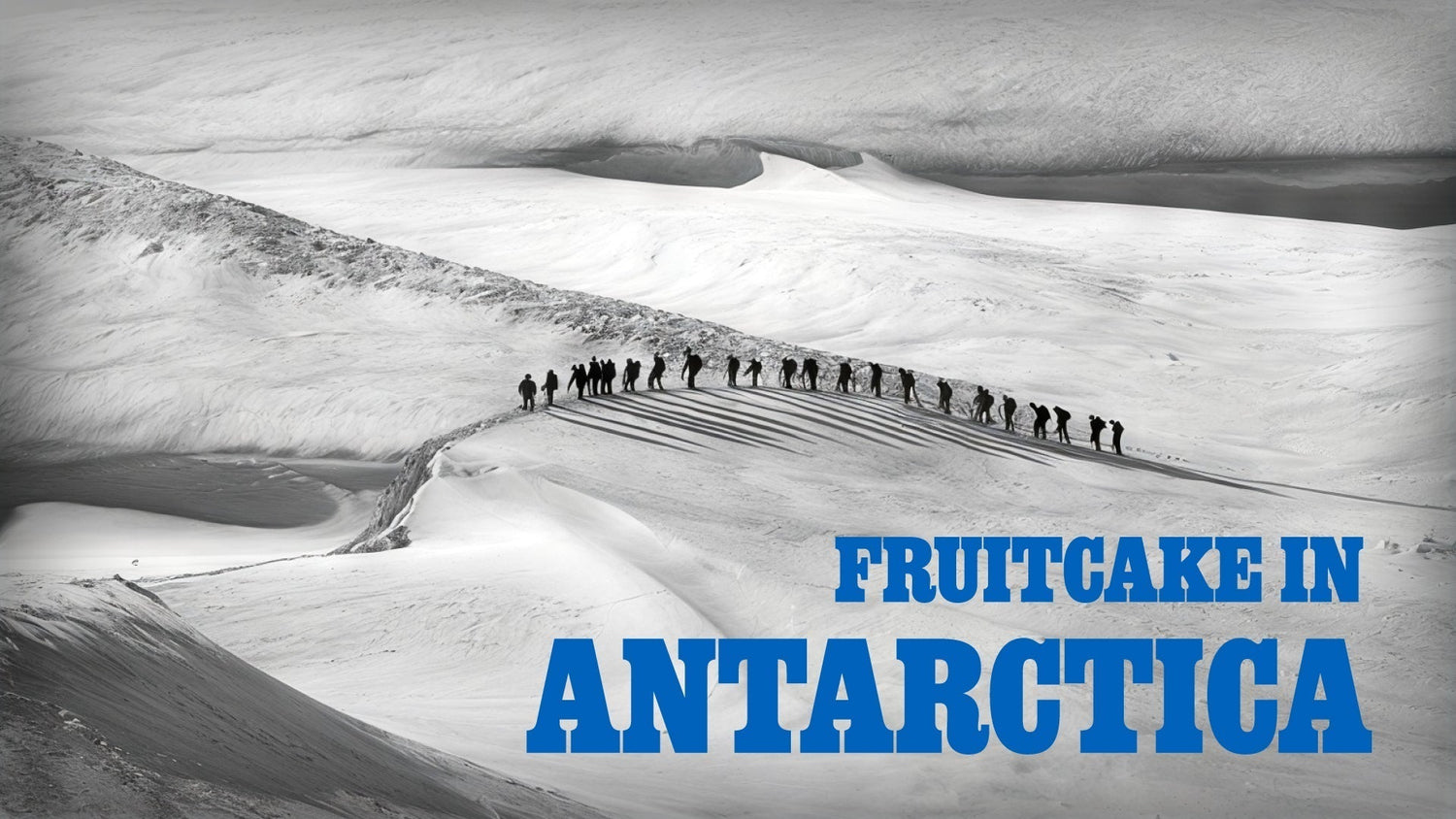How A 106-Year Old Fruitcake Fueled Scientific Discovery
The Antarctic desert is hardly where anyone would plan a luxury trip. Average continental temperatures range from -76 to 14 degrees Fahrenheit. Even with the best thermal gear, you’re looking at a pretty frosty stay. That is why it’s so amazing to think in a pre-Gore-Tex era, this frozen tundra was a destination of much excitement and intrigue.

Main Base hut at Cape Denison 1911 - Hurley, Frank, 1885-1962
Back in the early 19th century, little was known about the Antarctic. It was seen as one of the last unexplored regions of the world, attracting explorers of all kinds to its glacial shores. Fueled by the desire to discover, brave men, bundled up and plunged into the unknown. But the need to know more was not their only fuel. A certain tasty treat helped to fill their bellies. We’ll give you one guess… FRUITCAKE!
That’s right! Fruitcake helped fuel brave explorers across the Antarctic. The proof can actually be found on the continent itself. Recently, a 106-year old frozen fruitcake was found in a hut on Cape Adare, a prominent cape at the northern tip of the Adare Peninsula and the north-easternmost extremity of Victoria Land, East Antarctica.

Antarctic Heritage Trust
This fruitcake has actually been linked to one of the most tragic Antarctic exploration stories ever told. But it’s not the fruitcake’s fault!! Sometimes, explorers just bite off more than they can chew. Let’s start at the beginning…
Cue The Stories' Main Characters
In 1911, two vying groups of explorers endeavored to be the first humans ever to reach the middle-most point of the South Pole. The push to be the first was less about furthering the nature of scientific discovery, but more about claiming the honor and glory associated with being the first to do anything. It was, in a sense, like a lower-stakes Antarctic Space Race. The first group was led by Norwegian Roald Amundsen. The second was led by Britain's Robert Falcon Scott.
Both Amundsen and Scott were seasoned, decorated explorers. Their long list of accomplishments made both men appear equally as likely to claim the crown of being ‘the first.’

Roald Amundsen in 1913
In 1872, Amundsen had been the first mate on a Belgian expedition that had been the first-ever expedition to winter in the Antarctic. In 1897, he had also been the first to successfully navigate the Northwest Passage, a 900-mile sea route extending from the Atlantic Ocean to the Pacific Ocean. Historically, ice and treacherous conditions had made this route impassible, but Amundsen was able to successfully traverse the waters with a crew of only six men.
On the other hand, Scott was as comfortable on the sea as he was on land. He had joined the Royal Navy as a cadet in 1880 when he was just thirteen years old. By 1897, he had earned the rank of first lieutenant. In 1904, Scott returned from his first Antarctic expedition on the HMS Discovery. The expedition, which lasted four years, had proven Scott to be an adept and skilled leader. So, upon his return to England, he was promoted to the rank of captain.

Robert Falcon Scott in 1911
Inspired by his experiences on the HMS Discovery, Scott campaigned for the next six years to raise additional funds for a second Antarctic expedition. Simultaneously, Amundsen was also planning to embark on a second expedition, but to the opposite end of the world. Amundsen aspired to be the first man to reach the North Pole. BUT, shortly before Amundsen was scheduled to depart for the north, he learned an American by the name of Robert Peary had just achieved that feat. Quickly switching gears, Amundsen decided instead to race Scott to the southernmost tip of the Antarctic. However, Scott did not know he was facing competition. Amundsen had kept his change in plans a secret, hoping to narrowly edge Scott out of a victory.
In early 1911, Scott and his contingent of men began their way to Antarctica. Stopping in New Zealand to load their ship with supplies, Scott received a telegram notifying him of Amundsen and his crew on their way to the very same South Pole. Britain and Norway were now officially in a race.
Quickly, Scott packed up his crew and pushed towards the Antarctic. But before they even reached their intended campsite, Scott and his crew encountered issues. Overloaded with supplies, Scott’s ship, the Terra Nova, became stuck in ice off the coast for twenty days. As Scott put it, this delay was just “sheer back luck” but, it meant a portion of fuel and food intended for the journey had been consumed while waiting. After almost three weeks, the Terra Nova was able to break free and establish camp at Cape Evans off McMurdo Sound.

Scott's expedition ship Terra Nova visiting Fram in the Bay of Whales, February 1911
Upon arrival, the teams did not immediately depart for the pole. Scott had strategically timed their arrival to correspond with the Antarctic winter. The idea was, his team would divide their ranks and stay in a series of camps constructed along the glacier ridge during the coldest months. Then, when the brief Antarctic ‘summer’ arrived, Scott would lead one group inward while secondary teams stayed at the various border camps conducting scientific research. While Scott’s team divided to conquer, Amundsen made camp just off the Bay of Whales.
Amundsen’s camp was far better strategically placed, located sixty miles closer to the centermost point of the South Pole. However, Scott had a plan. He intended to follow in the footsteps of a fellow explorer, Robert Shackleton who had ventured to the Antarctic ten years earlier. At the time, Shackleton held the record for traveling the farthest south. Shackleton had mapped out a route for trekking to the center of the South Pole; a route that would have claimed him the crown of being the first to reach the pole. But due to illness, Shackleton had to turn back before completing his journey. By Scott’s logic, following Shackleton’s route was like following a precleared path to success.

On Your Marks, Get Set, GO!
On October 28, 1911, Amundsen’s team began their push to the pole, setting out using sleigh dogs. Three weeks later, Scott’s team began theirs using motor sleds, Siberian ponies, and sleigh dogs.
Due to the lack of technology of the day, both teams were blind to the process of the other group. Without knowing if they were ahead or behind, they were forced to push forward; the only way of discovering if they were first or not, was to make it to the Pole and see if a flag had already been staked. Simultaneously, it’s this exact same lack of technology that prevents modern-day scientists from examining exactly what happened on their trips. The best-kept historical records are in the form of journals, which were meticulously kept.
Documenting the temperature, terrain, and temperament of the explorers, it’s per these journals, scientists now know how a few weeks into Scott’s journey, he was forced to send the sleds and ponies back; despite being extraordinarily powerful, they were ill-equipped to handle the conditions. A few weeks after that, in mid-December, Scott was forced to turn the dogs back. This left Scott with just four other men to continue their ascent of the Beardmore Glacier. On January 17, 1912, Scott and his small contingent of men reached the South Pole only to find they had been beaten. Amundsen’s group had reached the pole over a month earlier. Scott writes…
- “Wednesday, January 17. Camp 69. T. -22ºF at start. Night -21ºF. The Pole. Yes, but under very different circumstances from those expected...the wind is blowing hard, T. -21ºF, and there is that curious damp, cold feeling in the air which chills one to the bone in no time... Great God! This is an awful place and terrible enough for us to have laboured to it without the reward of priority. Well, it is something to have got here, and the wind may be our friend tomorrow”
Despite their “second place” finish, Scott and his men knew they had accomplished something great. Stoically, they set their jaws and prepared for the 800-mile journey back to Camp Evans. The journey back was expected to be a more difficult journey than the one to the Pole. Weakened by the cold and continuous exertion, the crew faced extreme cold and bone-chilling winds. A never-ending flurry of blizzards left the men windburnt and frostbitten. Scott’s journal routinely comments on the injuries and trials he and his men suffer.
- “Tuesday, January 30. R. 13. 9860. Lunch Temp. -25ºF, Supper Temp. -24.5ºF. Wilson has strained a tendon in his leg.... [and] Evans..hands are really bad, and to my surprise, he shows signs of losing heart over it....”
- “Tuesday, February 6. Lunch 7900; Supper 7210. Temp. -15ºF.... this evening, though we are not as far advanced as I expected… It took us twenty-seven days to reach the Pole and twenty-one days back-in all forty-eight days-nearly seven weeks in low temperature with almost incessant wind...
- “Tuesday, February 28. Lunch. Thermometer went below -40ºF last night; it was desperately cold for us, but we had a fair night... Only twenty-four miles from the depot. The Sun shines brightly, but there is little warmth in it.”
- “Wednesday, March 7. A little worse I fear. One of Oates' feet very bad this morning; he is wonderfully brave. We still talk of what we will do together at home.”
- “Sunday, March 18. Today, lunch, we are twenty-one miles from the depot. Ill fortune presses, but better may come... The others are still confident of getting through-or pretend to be-I don't know!.... The mileage would have seemed ridiculously small on our outward journey.”
On March 20th 9012, a fierce blizzard ripped through the glacier terrain causing the men to take shelter and ride out the storm. It was this storm that seemed to push the already ragged and browbeaten men to their breaking point. Scott’s last journal entry seems to convey the bitter knowledge they would reach their demise before they reached their destination.
- “Thursday, March 29 Every day we have been ready to start for our depot 11 miles away, but outside the door of the tent, it remains a scene of whirling drift. I do not think we can hope for any better things now. We shall stick it out to the end, but we are getting weaker, of course, and the end cannot be far. It seems a pity but I do not think I can write more. R. Scott. Last entry. For God's sake look after our people.”
In 1913, the Terra Nova returned to Britain, sadly without Scott and four others who died on the return journey from the South Pole. But the whole expedition was not a loss. While Scott and his smaller crew carved their way through the icy tundra, Scott’s accompanying scientists who stayed at various camps around the edge of the ice shelf left with over 2,100 plants, animals, and fossils – 400 of which were entirely new to science. Scott’s team, “[his] people,” help lay the scientific groundwork for research in the years to come.
Their findings in Antarctic botany, zoology, geology, and glaciology were so vast, Scott’s and his crew earned spots as pioneers in the Heroic Age of Antarctic Exploration.
Fruitcake Fueled Exploration
So, this is interesting and all, but why do we here at Collin Street think Robert Falcon Scott is extra, super cool? Turns out, conservationists with the New Zealand-based Antarctic Heritage Trust recently discovered campsites on Cape Adare left by Scott and his scientists.
In August 2017, over 1,500 artifacts were excavated from a small that was used over 106-years prior. Among the artifacts, was a fruitcake. Perfectly preserved in the frozen climate, the cake was wrapped in paper, stored in the tin it had traveled in. After some digging around, it was determined Scott likely brought the cake from the British biscuit company Huntley & Palmers. "Fruitcake was a popular item in English society at the time, and it remains popular today," Lizzie Meek, Conservation Manager for Artifacts at the Trust. "Living and working in Antarctica tends to lead to a craving for high-fat, high-sugar food, and fruitcake fits the bill nicely, not to mention going very well with a cup of tea."

Antarctica Delta Trip to Cape Evans Scott's Hut -Eli Duke (2010)
The Heritage Trust conservators have been working to restore the 50-foot-long Terra Nova hut used by Scott and his crew. The Terra Nova hut was chosen because it’s been determined to be the largest Antarctic building of its time. The Trust’s goal is to return the huts to the way they looked at the time, even aspiring to restore the huts' artifacts, including the frozen fruitcake, to their original locations within the huts.
"Fruitcake is not something that people usually get excited about, but this discovery shows what a spectacular environment for historic preservation the Antarctic is," says Clemson University historian Stephanie Barczewski. It also highlights the “importance of protecting its fragile environment, because we don't know what other amazing things we might find from the Heroic Age of exploration."

So, there you have it, the proof was in the pecans – Scott’s men relied on a fruitcake as a high-calorie treat to propel their mission. As we know, this group of explorers wasn’t the last to use fruitcake as fuel. It’s still a widely-leveraged trick used by all sorts of modern-day adventurers.
Just ask Thea and Mary-Preston. For three months, they used fruitcake to help them conquer the Scottish National Trail. Or ask Tim Hoime! He successfully hiked the entire length of the Grand Canyon in just one day with the assistance of our DeLuxe® Fruitcake Petites. Makes you wonder, maybe Scott and his men might have had better fortune if they had chosen to pack Collin Street Bakery’s fruitcake instead…. I guess we’ll never know.












Leave a comment
This site is protected by hCaptcha and the hCaptcha Privacy Policy and Terms of Service apply.